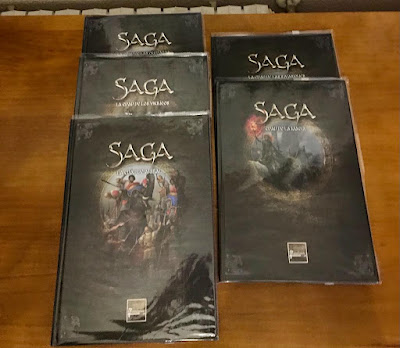In September this year I caught the Saga fever, which had previously infected many of my club's closest gaming buddies. To being now almost less fully dedicated to Saga will come as a surprise to readers of this blog, for two reasons: it is not a set of rules from the TooFatLardies stable and I´ve always pretended to be a historical wargamer (or so I say).
On the first, nothing to say; I´ve been more than once unfaithful to my beloved Richard Clarke ;-)
The second may need more elaboration as arguably Saga design is only loosely based on history, but hardly anything remotely close to the "play the history, not the rules" experience. Actually this has been blocking me to take on the rules for a long time, until I conceded to the club's gaming group pressure after the summer.
Surprisingly though, I'm enjoying Saga a lot: the rules are very easy to learn; you need just 25-30 minis to put a warband on the table; many of the minis are interchangeable between warbands (Vikings, Saxons, Anglo Saxons, etc); games are fast (60 to 90 minutes) and perfect for a Sunday morning at the club; battles are bloody and fun; and game scnearios are highly replayable.
Saga's success secret sauce falls in my view on two main ingredients:
- Streamlining the typical skirmish game mechanics, avoiding the more complex issues like using formations, variable (dice driven) movement rates, or frontage/flak/rear rules.
- On the other, the national (or better said, warbands) characteristic tables, enable each warband to use some special features singular to each, making them act different from each other and also allowing replayability.
The Saga books (all titled "The Age of___ Hannibal, Vikings, Invasions, etc) cover between the Hellenistic Alexander's battles (circa 320 BC) and The Crusades and The Reconquista (circa 1000+ AD). In addition a Fantasy battles book was also issued.
Do all lists work fine with the rules? Yes ... but only if you are not a picky historical player. My take is that typical warbands not trained to fight in formations are probably a better match for Saga.
To clarify: a typical unit of warriors comprises 8 models and a guards unit just 4 models. A unit of Roman legionaries (or a Maecedonian pike phalanx) with such few models does not feel right at all. However a group or irregular Vikings, Saxons, Gauls or Iberians raiding neighbouring villages or ambushing other units will do the trick.
In addition to period books, Saga has also released a specific campaign book in the Age of Vikings and a battles supplement with several types of scenarios, including rules to setup a table, objectives and alternative schemes to deploy troops.
All the books are printed as high quality hardbacks, nicely edited and lavishly illustrated with beautiful colour photos of the correspoding armies (useful also as painting guides for your units). The national characteristic lists are printed in thick board sheets and are worth laminating or protecting with a plastic cover.
The Saga Dice
Summarizing, an easy, fun, and well crafted set of rules, offering a with a wide array of army lists, highly replayable thanks to the national characteristics tables. Perfect to introduce new players directly into historical gaming (or indirectly using the fantasy battles book); or for the seasoned gamer to play a casual afternoon game in your club.





Interesting thoughts, as a newbie to Saga, when shown it, I came away with the feeling that the board building with dice took more precedence and pleasure for the guys playing that the actual fighting with the figures was almost secondary, and that the "cardsharps" players always won as a result.. but.. one girls view :)
ReplyDeleteOutside of TFL, I play Studio Tomahawk rules and Pulp Alley. SAGA is a great game.
ReplyDeleteThanks for an objective review, I'm closer to a purhase now...
ReplyDelete